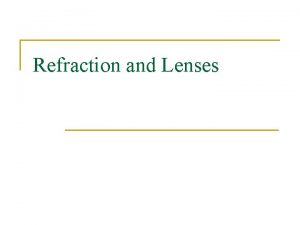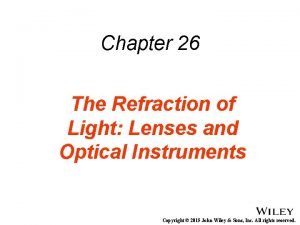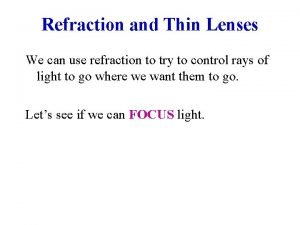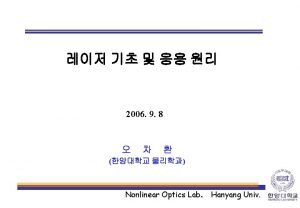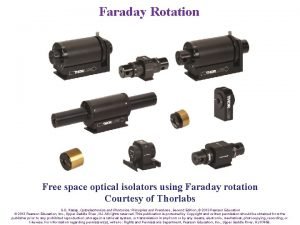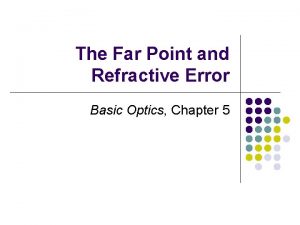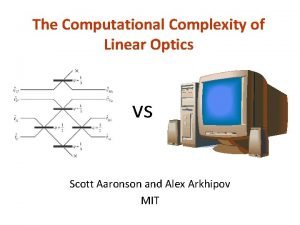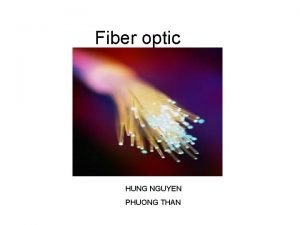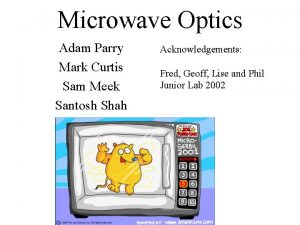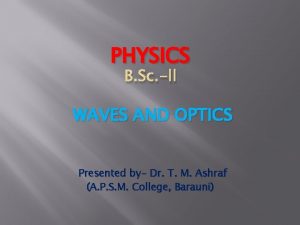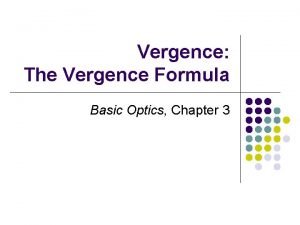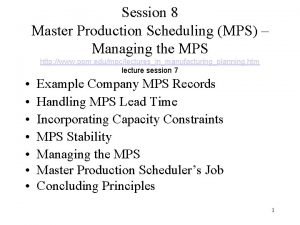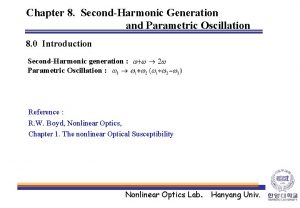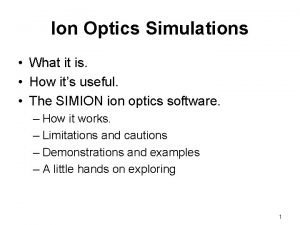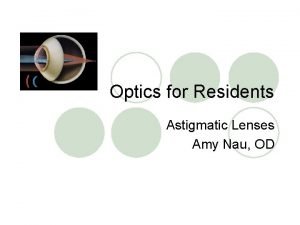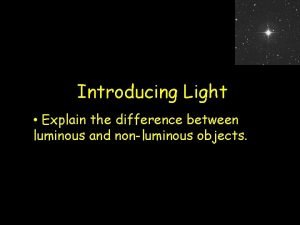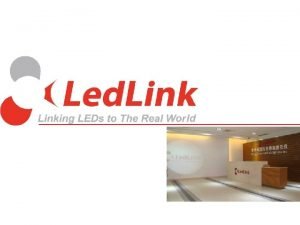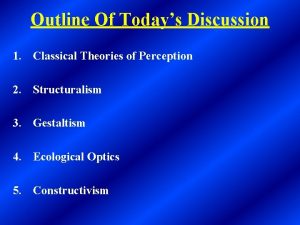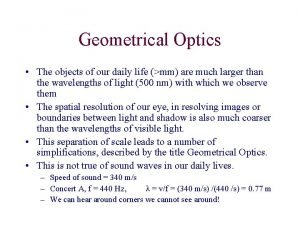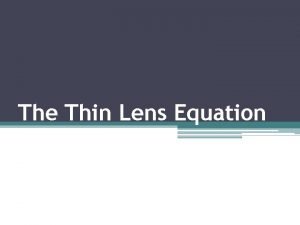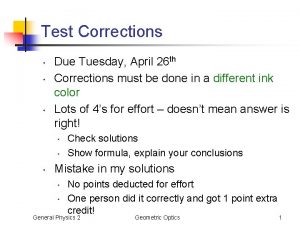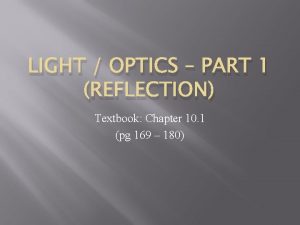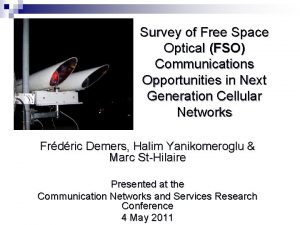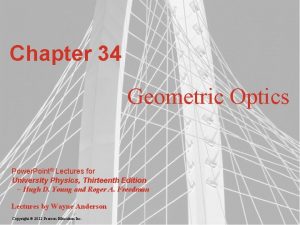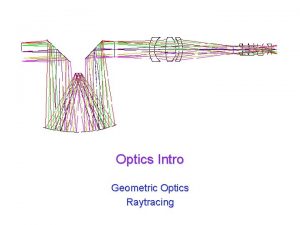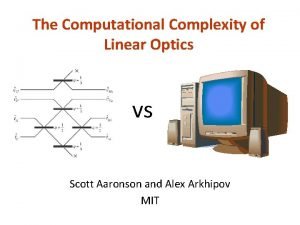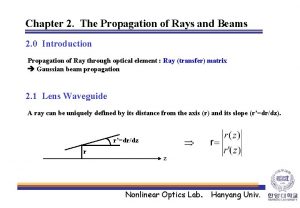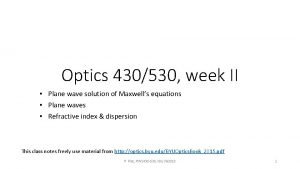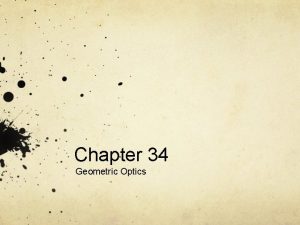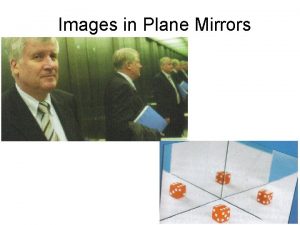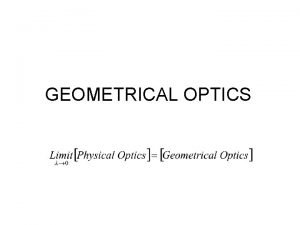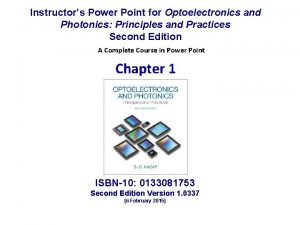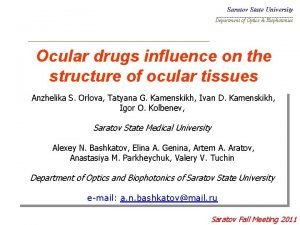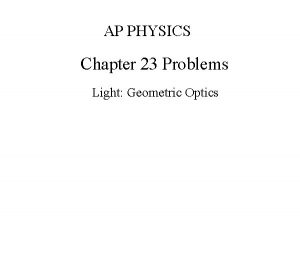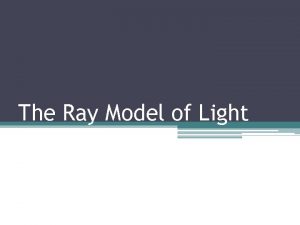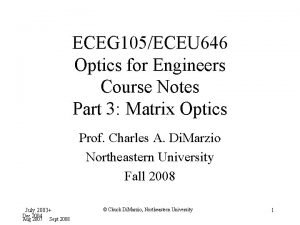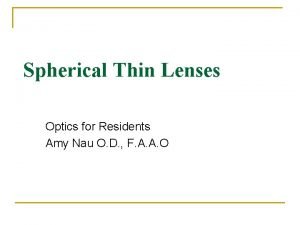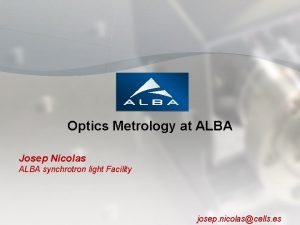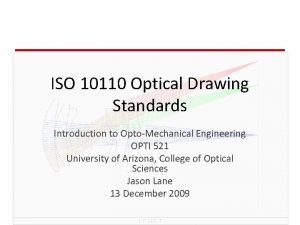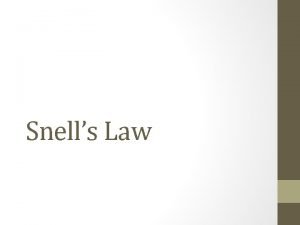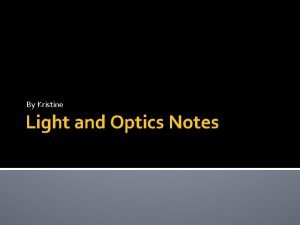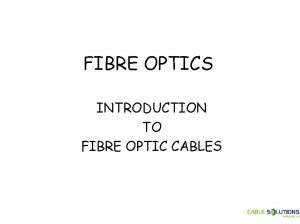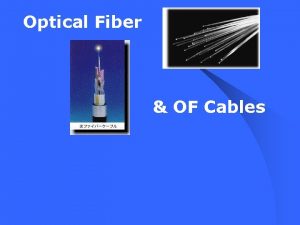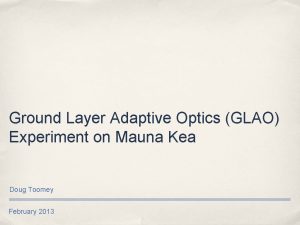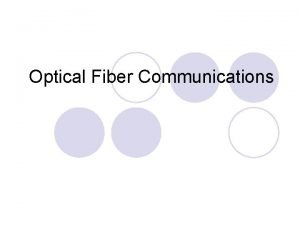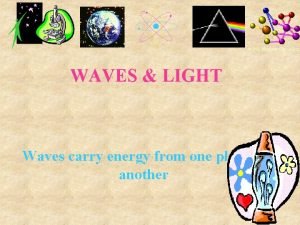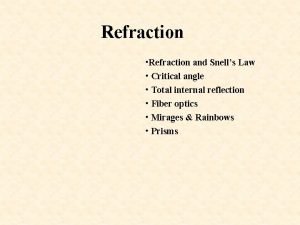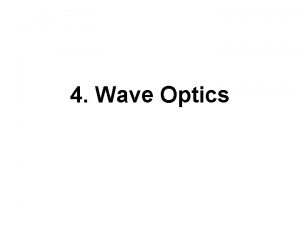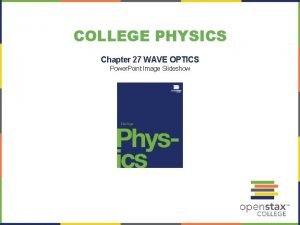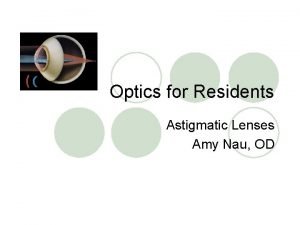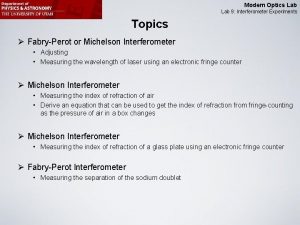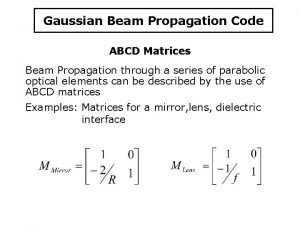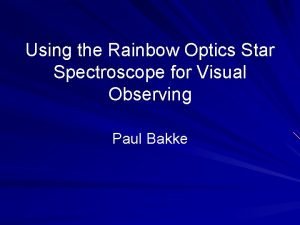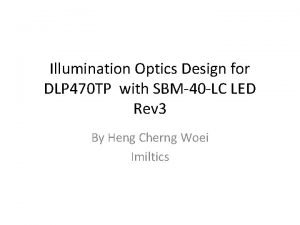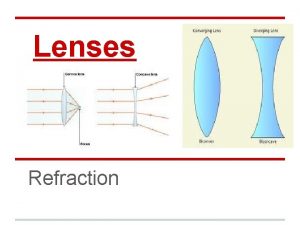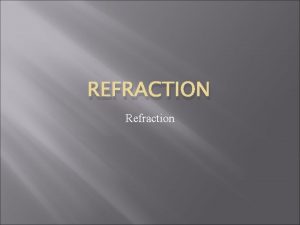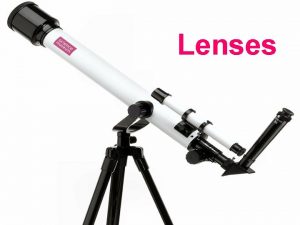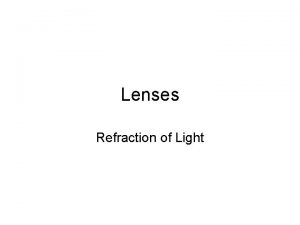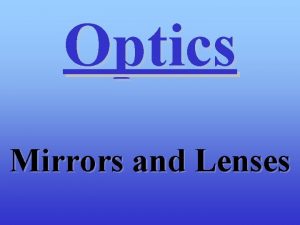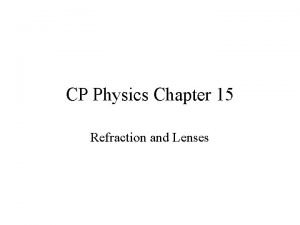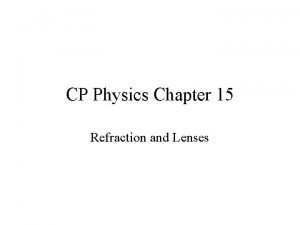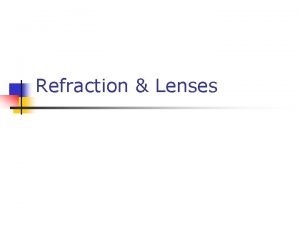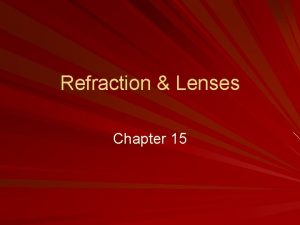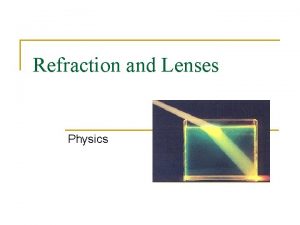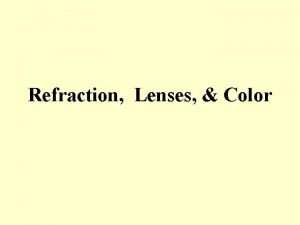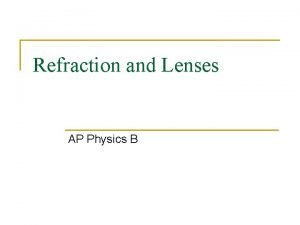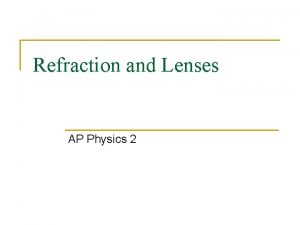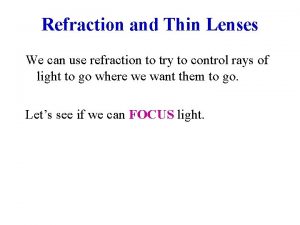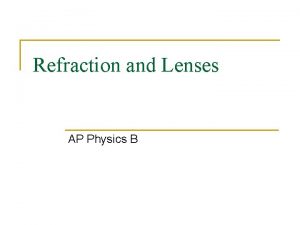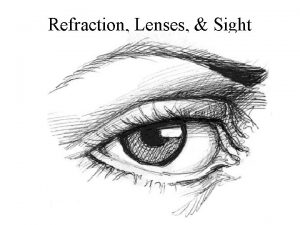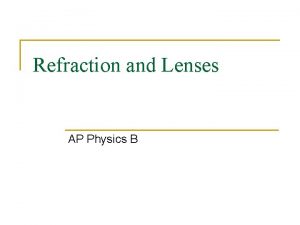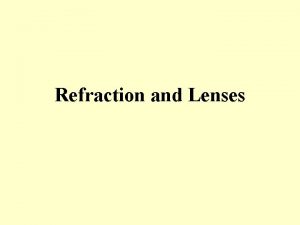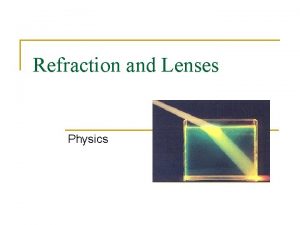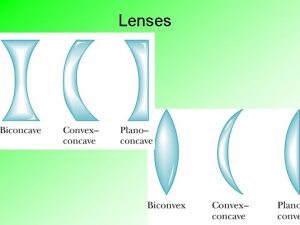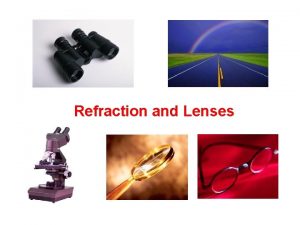Optics 2 REFRACTION LENSES REFRACTION Refraction is the










































































- Slides: 74

Optics 2: REFRACTION & LENSES

REFRACTION Refraction: is the bending of waves because of the change of speed of a wave when it passes from one medium to another. The greater the difference in the speed of the waves, the greater the bending of the waves.


Normal: the line perpendicular to the surface. Incident ray: is the ray of light that strikes the surface. Reflected ray: is the ray of light that bounces off the surface. Refracted ray: is the ray of light that enters the material. Point of Incidence: is the point at which the light strikes the surface.

Angle of Incidence: the angle between the incident ray and the normal to the surface. Angle of Reflection: the angle between the reflected ray and the normal to the surface. Angle of Refraction: the angle between the refracted ray and the normal to the surface.

When a ray of light travels from a less dense medium to a denser medium; the refracted ray moves towards the normal to the surface. Incident ray air water Refracted ray

When a ray of light travels from a denser medium to a less dense medium; the refracted ray moves away from the normal to the surface. Refracted ray air water Incident ray


The amount of refraction depends upon: 1. The material through which the light travels. 2. The wavelength of light. The shorter the wavelength, the greater the refraction.

Violet light has a smaller wavelength than the other colors in the visible spectrum. Therefore, it is refracted the most.

THE LAW OF REFRACTION The greater the value of n, the greater the refraction.

Medium Vacuum Air Water Ethanol Crown glass Quartz Flint Glass Diamond Refractive Index 1. 0003 1. 36 1. 52 1. 54 1. 62 2. 42

Example #1 The index of refraction of water is 1. 33. Calculate the speed of light in water.


Example #2 Find the speed of light in a) ethanol b) quartz c) flint glass.


Example #3 The speed of light in plastic is 2 x 108 m/s. What is the refractive index of the plastic?


SNELL’S LAW

Example #4 A light ray of wavelength 589 nm traveling through air strikes a smooth, flat slab of crown glass (refractive index 1. 52) at an angle of 300 to the normal. Find the angle of refraction. Incident ray Air=1. 00 Glass=1. 52 Refracted ray


Example #5 Light in air is incident upon a piece of crown glass at an 0 angle of 45. What is the angle of refraction?


Example #6 A block of unknown material is submerged in water (refractive index is 1. 33). Light in the water is incident on the block at an angle of 310. The angle of 0 refraction in the block is 27. What is the index of refraction of the unknown material?

Incident ray Water=1. 33 unknown Refracted ray


Critical Angle the incident angle that causes the incident ray to refract along the boundary between the two surfaces. R = 90° air water Refracted ray Incident ray



When the angle of incidence is less than the critical angle; normal refraction takes place. Refracted ray air water Incident ray

When the angle of incidence is equal to the critical angle; the refracted ray is on the boundary. Refracted ray air water Incident ray

When the angle of incidence is greater than the critical angle; total internal reflection occurs. There is no refracted ray. air Incident ray Reflected ray water

TOTAL INTERNAL REFLECTION CONDITIONS Light is going from a denser medium to a less dense medium. Light is incident at an angle greater than the critical angle.

TOTAL INTERNAL REFLECTION OUTCOMES There is no refracted ray. There is only a reflected ray that stays in the denser medium. Total internal reflection and proper faceting causes diamonds and crystal glass to sparkle brilliantly.

EFFECTS OF REFRACTION Mirages Lingering daylight after the sun is below the horizon. An object in water, appears to be closer than it really is. Spoon appears bent when placed in a glass of water.

LENSES Lenses are curved transparent objects. They form images through refraction of light. They are usually made from plastic or glass. Two main types of lenses: 1. Convex 2. Concave



Convex Lens

Convex Lens C F F C

C C Focus or Focal Point: is the point on the principal axis where the parallel rays all come together after passing through the lens. The distance between the focus and the center of the lens is called the focal length.

RULES FOR DRAWING CONVEX LENS RAY DIAGRAMS Any ray parallel to the optical axis will be refracted through F. C F F C

RULES FOR DRAWING CONVEX LENS RAY DIAGRAMS Any ray passing through F will be refracted parallel to the principal axis. C F F C

RULES FOR DRAWING CONVEX LENS RAY DIAGRAMS Any ray passing through O continues straight through C F F C

When object is between F and O Image is Virtual Enlarged And Upright Used in a magnifying glass C F F C

When object is at F No image is formed Used in a telescope. C F F C

When object is between F and C Image is enlarged, real, and inverted Used in optical instruments. C F F C

When object is at C Image is same size, real, and inverted Used in optical instruments. C F F C

When object is beyond C Image is reduced, real, and inverted Used in optical instruments. C F F C

Concave Lens

Concave Lens C F F C

RULES FOR DRAWING CONCAVE LENS RAY DIAGRAMS Any ray parallel to the optical axis appears to be refracted through F. C F F C

RULES FOR DRAWING CONCAVE LENS RAY DIAGRAMS Any ray passing through O continues straight through C F F C

Object is placed between F and the Lens Image is reduced, virtual, and upright Used in telescopes and cameras. C F F C

Object is placed at F Image is reduced, virtual, and upright Used in telescopes and cameras. C F F C

Object is placed between F and C Image is reduced, virtual, and upright Used in telescopes and cameras. C F F C

Object is placed at C Image is reduced, virtual, and upright Used in telescopes and cameras. C F F C

Object is placed beyond C Image is reduced, virtual, and upright Used in telescopes and cameras. C F F C

Lens Equation f is negative if lens is concave di is negative if image is virtual, if image is formed on the same side as the object di is positive if image is real, if the image is formed on the opposite side as the object hi is negative if image is inverted M < 1 the image is smaller than the object M > 1 the image is larger than the object

Example #7 An object is 32 cm to the left of a convex lens of 8 cm focal length. Use the equation to locate the image.


Example #8 A 20 cm high object is placed 10 cm in front of a concave lens with a focal length of 10 cm. Find the image distance, magnification, and height. Describe the image. Draw a ray diagram.


C F F C

Example #9 An object is placed to the left of a 25 mm focal length convex lens, so that its image is the same size as the object. What is the image and object location?


Example #10 An object is placed 30 cm in front of a converging lens with a focal length of 10 cm. Find the image distance, magnification, and describe the image.


LASER Is a device that produces an intense, nearly parallel beam of coherent light. They are very high energy light sources.


EYE DEFECTS Farsightedness: person cannot focus near by objects. Far away objects appear clear while closer objects appear blurred. The person has an abnormality called hyperopia. The image is focused behind the retina.

CORRECTION OF FARSIGHTEDNESS

EYE DEFECTS Nearsightedness: person cannot focus far away objects. Near by objects appear clear while objects further away appear blurred. The person has an abnormality called myopia. The image is focused in front of the retina.

CORRECTION OF NEARSIGHTEDNESS
 Difference between ray optics and wave optics
Difference between ray optics and wave optics Venn diagram of geometric optics and physical optics
Venn diagram of geometric optics and physical optics Refraction by a lens
Refraction by a lens Refraction of light in lenses
Refraction of light in lenses What kind of shape
What kind of shape Http //www.phys.hawaii.edu/ teb/optics/java/slitdiffr/
Http //www.phys.hawaii.edu/ teb/optics/java/slitdiffr/ Nonlinear optics
Nonlinear optics Nonlinear optics
Nonlinear optics Far point of emmetropic eye
Far point of emmetropic eye The computational complexity of linear optics
The computational complexity of linear optics Dr hung nguyen
Dr hung nguyen Geometrical
Geometrical Adam ekt eva
Adam ekt eva Wave optics b.sc physics
Wave optics b.sc physics Vergence formula optics
Vergence formula optics The spencer optics company produces an inexpensive
The spencer optics company produces an inexpensive Purtubation
Purtubation Ion optics simulation
Ion optics simulation Maddox rod optics
Maddox rod optics What is the difference between luminous and non luminous
What is the difference between luminous and non luminous Optics
Optics Ledlink optics inc
Ledlink optics inc Introduction to fiber optics
Introduction to fiber optics Ecological optics
Ecological optics Total internal reflection in daily life
Total internal reflection in daily life With the rule astigmatism
With the rule astigmatism Thin lens equation rearranged
Thin lens equation rearranged Ee
Ee Geometric optics
Geometric optics First light optics
First light optics Free space optics
Free space optics Optics plural or singular
Optics plural or singular Geometrical optics ppt
Geometrical optics ppt Optics
Optics The computational complexity of linear optics
The computational complexity of linear optics Nonlinear optics
Nonlinear optics Hotwire fiber optics
Hotwire fiber optics Eikonal equation optics
Eikonal equation optics Optics poynting's theorem
Optics poynting's theorem Divergin
Divergin Salt image characteristics
Salt image characteristics Free space optics
Free space optics Laws of optics
Laws of optics Cauchy formula optics
Cauchy formula optics Turba optics
Turba optics Optics
Optics Optics
Optics Name the two parts that make up most mirrors.
Name the two parts that make up most mirrors. Optics
Optics Nau optics
Nau optics Grade 10 optics review
Grade 10 optics review Optics
Optics Fiber optics richard sanders
Fiber optics richard sanders Iso drawing standards
Iso drawing standards Snells law example
Snells law example Single slit envelope
Single slit envelope Light and optics notes
Light and optics notes Introduction of fibre
Introduction of fibre Disadvantage of fiber optic cable
Disadvantage of fiber optic cable Optical fiber advantages and disadvantages
Optical fiber advantages and disadvantages Free space optics
Free space optics Adaptive optics
Adaptive optics Optical power loss
Optical power loss What medical procedure uses fiber optics bill nye
What medical procedure uses fiber optics bill nye Critical angle in refraction
Critical angle in refraction Fourier optics
Fourier optics Superconducting devices in quantum optics
Superconducting devices in quantum optics Optics
Optics Maddox rod
Maddox rod Purdue phys 241
Purdue phys 241 Modern optics experiment
Modern optics experiment Gaussian beam abcd matrix
Gaussian beam abcd matrix Light energy bill nye
Light energy bill nye Rainbow optics star spectroscope
Rainbow optics star spectroscope 368x5
368x5


